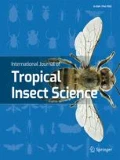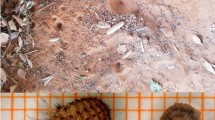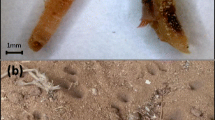Abstract
The biotic and abiotic factors of an ecosystem exert an influence on the behavior and survival of organisms, which adapt to changes in these factors to ensure their reproduction and survival. Phenotypic plasticity regards any type of change induced by the environment without the need for genetic modifications. The aim of the present study was to evaluate whether the investment of the antlion, Myrmeleon brasiliensis (Neuroptera, Myrmeleontidae) in trap building is a phenotypic response that changes according to the surrounding environment. Larvae were observed in their natural environment (control), in a simulated natural environment (below tents) and after being transplanted to the laboratory. We found that the investment in trap size is a plastic phenotypic response in M. brasiliensis larvae and this behavior varies in accordance with the location in which the larvae build their traps. In areas with protection for the traps, greater investment was made in the size of the trap and consequently increased the success in capturing prey.


Similar content being viewed by others
References
Boggs CL, Freeman KD (2005) Larval food limitation in butterflies: effects on adult resource allocation and fitness. Oecologia 144:353–361
Briffa M, Rundle SD, Fryer A (2008) Comparing the strength of behavioural plasticity and consistency across situations: animal personalities in the hermit crab Pagurus bernhardus. Proceedings. Biological Sciences - the Royal Society 275:1305–1311
Day MD, Zalucki MP (2000) Effect of density on spatial distribution, pit formation and pit diameter of Myrmeleon acer Walker (Neuroptera: Myrmeleontidae): patterns and processes. Aust J Ecol 25:58–64
Dias SC, Santos BA, Werneck FP, Lira PK, Carrasco-Carbadilo V, Fernandes GW (2006) Efficiency of prey subjugation by one species of Myrmeleon larvae (Neuropetra: Myrmeleontidae) in the central Amazônia. Braz J Biol 66:441–442
Devetak D, Ncinger-Vracko B, Devetak M, Marhl M, Spernjak A (2007) Sand as a medium for transmission of vibratory signals of prey in antlions Euroleon nostras (Neuroptera: Myrmeleontidae). Physiol Entomol 32:268–274
Elimelech E, Pinshow B (2008) Variation in food availability influences prey-capture method in antlion larvae. Ecol Entomol 33:652–662
Faria ML, Prado PI, Bedê LC, Fernandes GW (1994) Structure and dynamics of a larval population of Myrmeleon uniformis (Neuroptera: Myrmeleontidae). Braz J Biol 335–344
Farji-Brener AG (2003) Microhabitat selection by antlion larvae, Myrmeleon crudelis: effect of soil particle size on pit-trap design and prey capture. J Insect Behav 16:783–796
Fertin A, Casas J (2006) Efficiency of antlion trap construction. J Exp Biol 209:3510–3515
Freire LMN, Lima TN (2019) Effect of rain on trap building by Myrmeleon brasiliensis in a riparian woodland from the Cerrado biome in Brazil. Entomol Exp Appl 167:1–5
Franks NR, Worley A, Falkenberg M, Sendova-Franks AB, Christensen K (2019) Digging the optimum pit: antlions, spirals and spontaneous stratification. Proc R Soc 286:20190365
Griffiths D (1980) The feeding biology of ant-lion larvae: prey capture, handling and utilization. J Anim Ecol 49:99–125
Griffiths D (1986) Pit construction by antlion larvae: a cost-benefit analysis. J Anim Ecol 55:39–57
Gotelli NJ (1993) Ant Lion zones: causes of high-density predator aggregations. Ecology 74:226–237
Guillette LM, Hollis KL, Markarian A (2009) Learning in a sedentary insect predator: Antlions (Neuroptera: Myrmeleontidae) anticipate a long wait. Behav Process 80:224–232
Honek A (1993) Intraspecific variation in body size and fecundity in insects: a general relationship. Oikos 66:483–492
Hauber ME (1999) Variation in pit size os antlion (Myrmeleon carolinus) larvae: the importance of pit construction. Physiol Entomol 24:37–40
Hoffman AA, Hallas R, Sinclair C, Mitrowski P (2001) Levels of variation in stress resistance in Drosophila among strains, local populations, and geographic regions: patterns for desiccation, starvation, cold resistance, and associated traits. Evolution 55:1621–1630
Harwood JD, Sunderland KD, Symondson WOC (2003) Web-location by linyphiid spiders: prey-specific aggregation and foraging strategies. J Anim Ecol 72:745–756
Kolss M, Vijendravarma RK, Schwaller G, Kawecki TJ (2009) Life-history consequences of adaptation to larval nutritional stress in Drosophila. Evolution 63:2389–2440
Klokocovnik V, Devetak D, Orlacnik M (2012) Behavioral plasticity and variation in pit construction of antlion larvae in substrates with different particle sizes. Ethology 118:1–9
Klokocovnik V, Hauptman G, Devetak D (2015) Effect of substrate temperature on behavioural plasticity in antlion larvae. Behaviour 153:1–18
Lucas JR (1982) The biophysics of pit construction by antlion larvae (Myrmeleon, Neuroptera). Anim Behav 30:651–664
Lucas JR (1985) Partial prey consumption by antlion larvae. Anim Behav 33(3):945–958
Lima TN, Faria RR (2007) Microhabitat selection by ant-lion Larvae Myrmeleon brasiliensis (Návas) (Neuroptera: Myrmeleontidae), in a Forest Reserve, Aquidauana, State of Mato Grosso do Sul. Neotrop Entomol 36:812–814
Lima TN, Lopes FS (2016) Effect of density, disturbance and food on displacement of the Myrmeleon brasiliensis (Navás 1914) (Neuroptera, Myrmeleontidae). Ecol Austral 26:166–170
Mansell MW (1996) Predation strategies and evolution in antlions (Insecta: Neuroptera: Myrmeleontidae). Pure and Applied Research in Neuropterology (ed. by M. Canard, H. Aspock and M. W .Mansell), pp. 161–169. Sacco, France
Mansell MW (1999) Evolution and success of antlions (Neuropterida: Neuroptera: Myrmeleontidae). Stapfia 60:49–58
Morrison LW (2004) Spatiotemporal variation in antlion (Neuroptera: Myrmeleontidae) density and impacts on ant (Hymenoptera: Formicidae) and generalized arthropod foraging. Ann Entomol Soc Am 97:913–922
Miyashita T (2005) Contrasting patch residence strategy in two species of sit-and-wait foragers under the same environment: a constraint by life history? Ethology 111:159–167
Mencinger-Vracko B, Devetak D (2008) Orientation of the pit-building antlion larva Euroleon (Neuroptera, Myrmeleontidae) to the direction of substrate vibrations caused by prey. Zoology 111:2–8
Ngamo LST, Maogé J, Thomas K (2016) Diversity of pit building antlions (Neuroptera: Myrmeleontidae) and their potential preys in the sudano Guinean zone of Cameroon. J Entomol Zool Stud 4:198–202
Orians GH (1991) Habitat selection: preface. Am Nat 137:1–4
Relyea RA (2003) Predators come and predators go: the reversibility of predator-induced traits. Ecology 84:1840–1848
Scheiner SM (1993) Genetics and evolution of phenotipic plasticity. Ann Rev Ecol Syst 24:35–68
Sokolovska N, Rowe L, Johansson F (2000) Fitness and body size in mature odonates. Ecol Entomol 25:239–248
Scharf I, Lubin Y, Ovadia O (2011) Foraging decisions and behavioural flexibility in trap-building predators: a review. Biol Rev 86:626–639
Thompson JD (1991) Phenotypic plasticity as a component of evolutionary chance. Trends Ecol Evol 6:246–249
Via S, Gomulkiewicz R, Dejong G, Scheiner SM, Schlichting CD, Van Tienderen PH (1995) Adaptive phenotypic plasticity. Consensus and Controversy Trends Ecol Evol 10:212–217
Yahner RH, Mahan CG (2002) Animal Behavior in Fragmented Landscapes. In: Applying landscape ecology in biological conservation, (Ed. by K. Gutzweille), pp. 518. New York: Springer
Acknowledgements
We thank Lionel A. Stange for the identification of the antlion.
Author information
Authors and Affiliations
Corresponding author
Additional information
Publisher's Note
Springer Nature remains neutral with regard to jurisdictional claims in published maps and institutional affiliations.
Rights and permissions
About this article
Cite this article
Abot, A.R., Arguelho, E.G. & do Nascimento Lima, T. Foraging behavior plasticity in antlion larvae Myrmeleon brasiliensis (Neuroptera, Myrmeleontidae). Int J Trop Insect Sci 42, 591–595 (2022). https://doi.org/10.1007/s42690-021-00577-6
Received:
Accepted:
Published:
Issue Date:
DOI: https://doi.org/10.1007/s42690-021-00577-6




